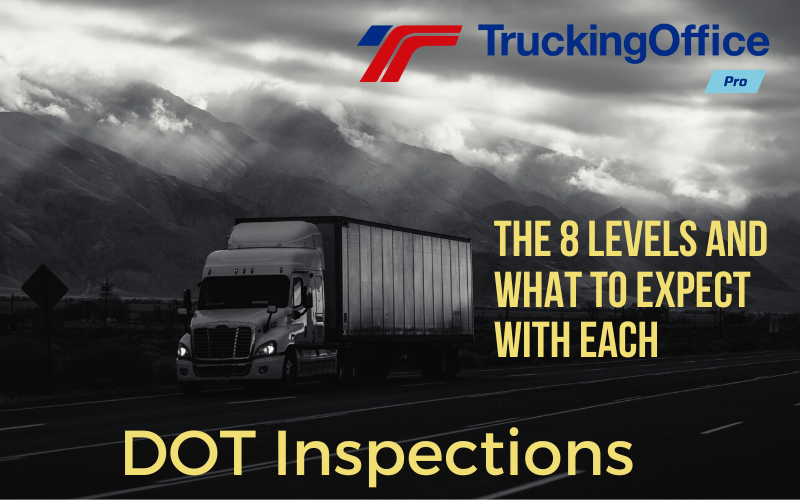If you have (or are beginning to have) interest in the trucking business, you probably know about the annual DOT inspection. The Department of Transportation does this inspection. It’s often done on all commercial motor vehicles (CMVs) weighing 10,001 pounds, and above. Furthermore, the sole objective of this process is to ensure that every part or accessory of a CMV is in excellent condition, functioning correctly, and safe to use. TruckingOffice PRO can help you with these inspections.
Levels of DOT Inspection
There are eight levels of DOT truck inspections. These will be conducted by a state police officer or a qualified inspector. Now, we’ll explore the eight inspection levels below.
North American Standard Inspection
This is the first level of DOT truck inspection. It is the most common and most comprehensive. During these checks, the inspector usually looks at essential documents, such as;
- Commercial Driver license
- Record of duty status (RODs) compliance
- Hours of service records, and more
TruckingOffice PRO stores all of these documents for you, especially if you’re using the TruckingOffice ELD to track your HOS.
Vehicle/Walk-Around Driver Inspection
The second level of inspection is much similar to the first level. However, the inspector or officer does not go underneath your vehicle to look at anything.
Driver-Only Inspection
The next level is the driver-only inspection. It involves an in-depth examination of the vehicle operator credentials. Furthermore, inspectors often check the drivers for RODs and skill performance evaluation (SPC) certificate. In addition, reviewing of driver’s license, seat belt usage, and medical certification may also be involved. Driver medical renewals and other data can be stored in the TruckingOffice PRO trucking software.
Special Inspection
Level 4 inspection involves checking for a specific feature of your vehicle. For instance, the inspector might just look at the valves, and nothing more. It is usually a result of a suspected trend among specific types of equipment.
Vehicle-only Inspection
As the name suggests, the level five inspection involves a thorough examination of the vehicle. This inspection will mostly occur after an incident or accident that happened in the absence of the driver. Much like Level 1, the inspector will have to get under the vehicle to take a look at the brakes, suspensions, and exhaust systems. Additionally, wheel assemblies, steering mechanism, and electrical system are among other areas the inspector may focus on.
Enhanced North American Standard (NAS) Inspection
Level VI inspections are done to ensure that the HRCQ or Highway Route Controlled Quantities of Radioactive Material meet the North American Standards. It often includes examining, among other things, radiological shipments and the inspection procedures.
Jurisdictional Mandated Commercial Vehicle Inspection
Usually, jurisdictionally mandated commercial vehicle inspection applies to selected commercial vehicles. These include, but not limited to, limousines, shared-ride transportation, school buses, and taxis. In most cases, level VII inspections will be carried out by CVSA-certified inspectors, jurisdiction-approved contractors, or other designated government employees. Although a jurisdiction-specific decal may be applied, you’ll get no CVSA decal for a Level VII Inspection.
North American Standard Electronic Inspection
This is the last level of inspection. This electronic inspection will likely be conducted while the vehicle is still in motion. In addition, it’s often done without direct interaction with a safety officer. Level VIII inspection must include appropriate driver’s license class, USDOT or (Canada) NSC number, and hours-of-service compliance. A descriptive location that shows GPS coordinates is also integral.
If you are not sure how to prepare for the rigorous DOT inspection process, look no further than our trucking management software. It will allow you to use pre-built checklists and do more than just vehicle inspecting the field. To learn more about the TruckingOffice solution, be sure to give us at (800) 253-9647.
What Happens if I Don’t Pass the Inspection?
The Department of Transportation seeks to ensure that every CMV is in excellent condition and safe to operate on America’s highways. Therefore, all commercial vehicles and drivers are subject to regularly scheduled inspections conducted by the DOT.
The DOT notifies you of an upcoming audit and you must call the FMCSA within 90 days to set up a date and time for your audit. If you fail to keep the appointment, your operating authority will be revoked.
If you fail the drug or alcohol test, you must complete a return-to-duty process with a DOT-qualified substance abuse professional. Unfortunately, the failure will make it difficult for you to get another driving job for over a year or more. You should also know that completing the return-to-duty process does not obligate the company to rehire you.
DOT trucking regulations are in place to make transportation safer for truckers and everyone else driving on our nation’s roads. At TruckingOffice, we understand your anxiety about DOT audits. That’s why we offer a TMS package that will help you prepare for the next DOT audit and, more specifically, make all aspects of your job easier. Check out our TMS here with this 30-day free trial.







Trackbacks/Pingbacks